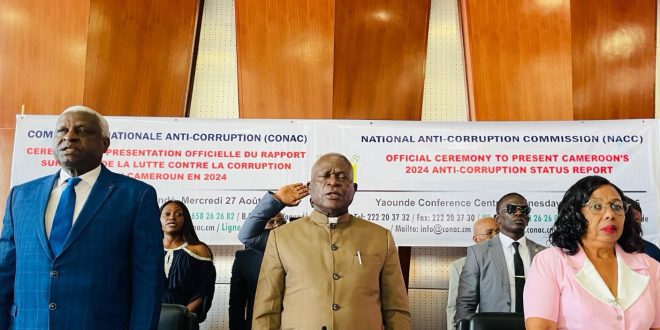CameroonOnline.ORG | Cameroon’s National Anti-Corruption Commission (CONAC) has released its 14th annual report, revealing a dramatic reduction in the financial damage caused by corruption. According to the figures, losses dropped from 114.035 billion FCFA in 2023 to just 4.061 billion FCFA in 2024—a decrease of about 96.5 percent. On paper, the state appears to have been spared more than 110 billion FCFA compared with the previous year.
While the numbers are striking, they also raise important questions about how corruption is measured, how cases are classified, and whether this apparent progress reflects a deeper structural shift or simply changes in reporting and case selection.
Why Such a Sharp Decline?
The report attributes the drop largely to differences in the type and scope of cases handled. In 2023, the high total came from a relatively small number of large-scale investigations—16 missions carried out by CONAC and 43 major rulings from the Budgetary and Financial Disciplinary Council (CDBF) and the Special Criminal Court (TCS). These few, but significant, cases pushed the estimated damage far above earlier years.
In 2024, the situation looked different. More complaints were filed, but they mostly involved smaller amounts of money—ranging from irregular payments for birth certificates, exam fees, and driving permits, to misuse of funds in minor administrative procedures. The financial harm appeared smaller, but that does not necessarily mean corruption itself was less widespread.
More Reports, Smaller Cases
The number of citizen reports submitted to CONAC actually increased in 2024, reaching 10,520, up nearly 40 percent from 2023. Expanded reporting channels, including hotlines, email, and messaging platforms, helped encourage more participation.
This raises an interesting paradox: while more people reported corruption, the financial totals dropped drastically. This could indicate that citizens are more willing to denounce smaller, everyday infractions, while large-scale cases may be less visible—or less frequently pursued.
Sanctions and Enforcement
The report notes a series of sanctions in 2024:
-
298 public officials suspended, including 14 ordered to repay a total of 34.6 million FCFA.
-
221 students punished for academic fraud.
-
216 private companies banned from public procurement due to contract failures.
-
14 forestry operators suspended for noncompliance with regulations.
These actions suggest a consistent level of administrative enforcement. However, the monetary sums involved are minor compared with the hundreds of billions previously reported, which raises the question of whether larger cases are slipping through the cracks.
The Unseen Side of Corruption
CONAC itself admits that its figures do not represent the whole picture. The totals only include cases that are reported, investigated, and quantified. Many instances of corruption may remain undocumented, unresolved, or politically sensitive.
This caveat is important: a decline in recorded financial harm does not necessarily mean corruption has decreased. It may simply mean fewer large cases were pursued in 2024.
Looking Ahead
The report also outlines recommendations that have been repeated for years:
-
Implementing mandatory asset declarations for public officials.
-
Criminalizing illicit enrichment.
-
Protecting whistleblowers.
-
Strengthening the management of recovered assets.
-
Extending oversight capacity at local levels of government.
Whether these reforms move forward remains to be seen. Without them, the impressive drop in reported financial damage could remain more of a statistical anomaly than proof of lasting change.
Conclusion
Cameroon’s 2024 anti-corruption report paints a picture of massive progress, with reported financial losses falling by more than 100 billion FCFA. Yet the reality is less clear. The numbers may reflect shifts in reporting and case size rather than a fundamental reduction in corruption.
As citizen complaints rise but large-scale cases fade from the statistics, skepticism is warranted. Until deeper reforms are implemented and enforcement proves consistent at all levels, the fight against corruption will remain an unfinished story—measured as much by what is left unreported as by what is recorded.
 CameroonOnline.org Cameroon news, Actualité Camerounaise, live Web TV & Radio, World News and a lot more
CameroonOnline.org Cameroon news, Actualité Camerounaise, live Web TV & Radio, World News and a lot more




